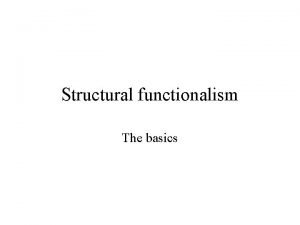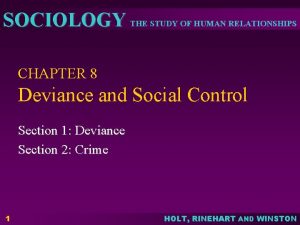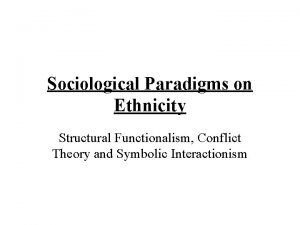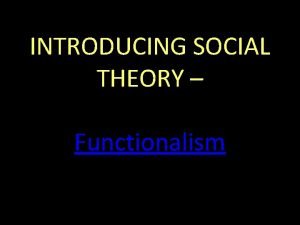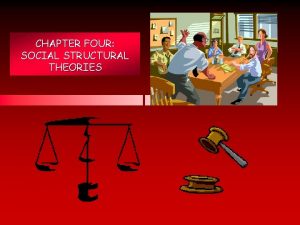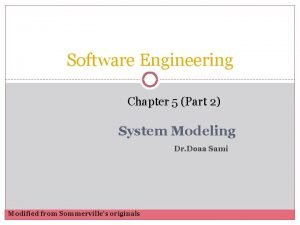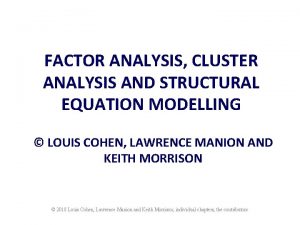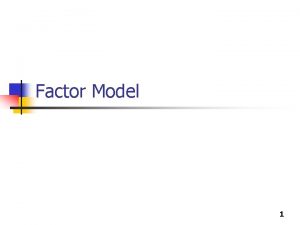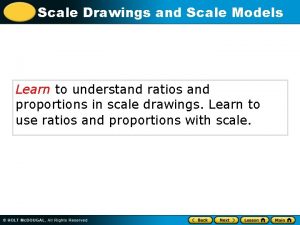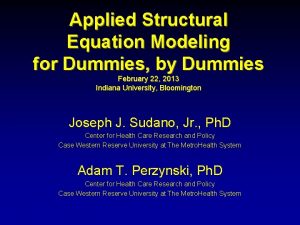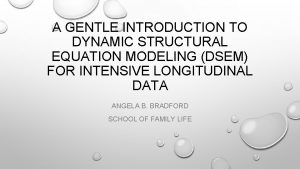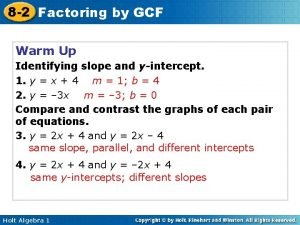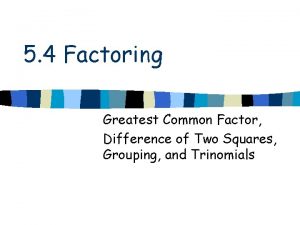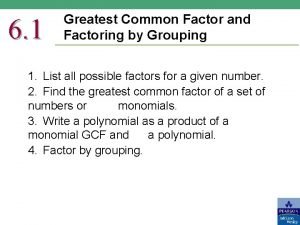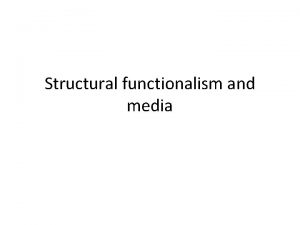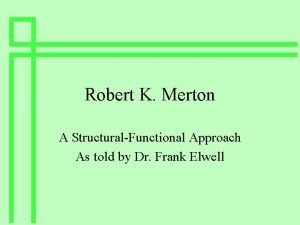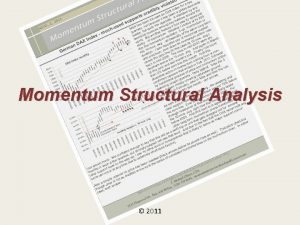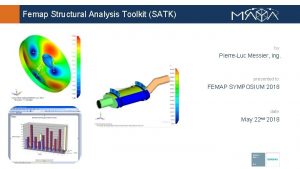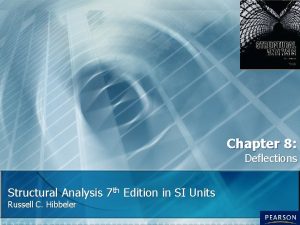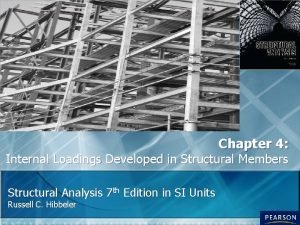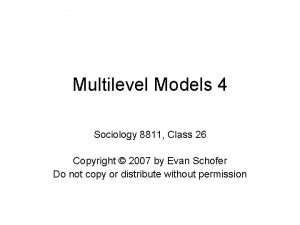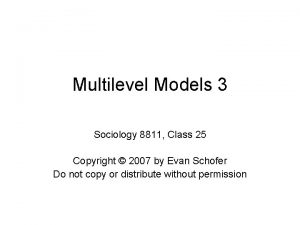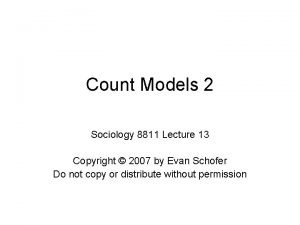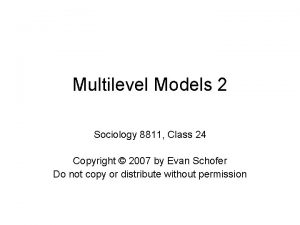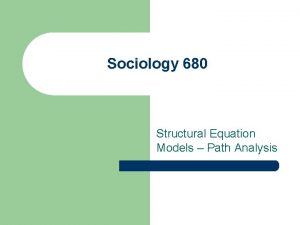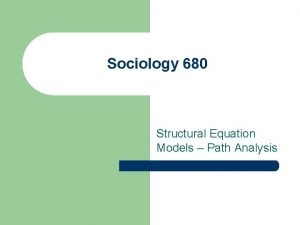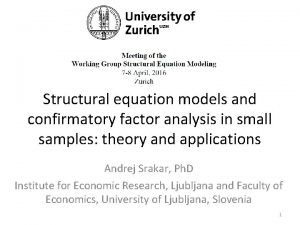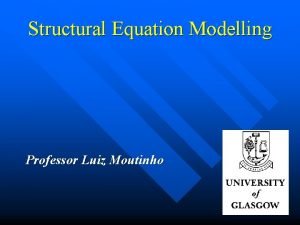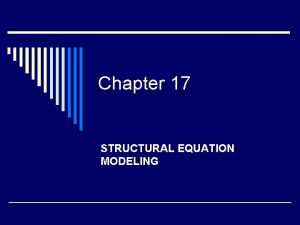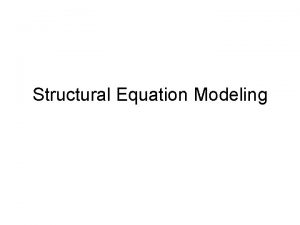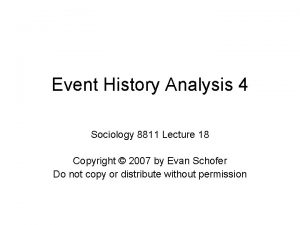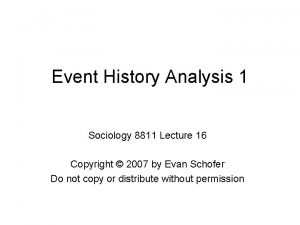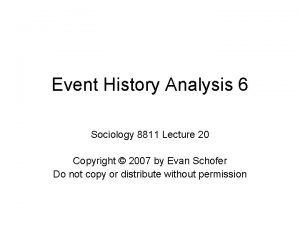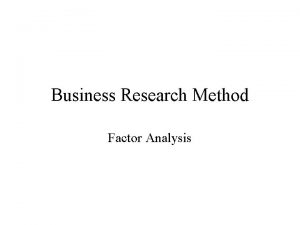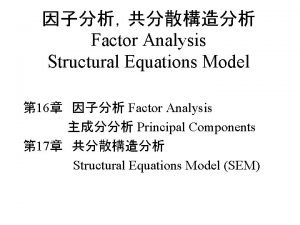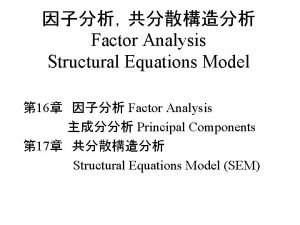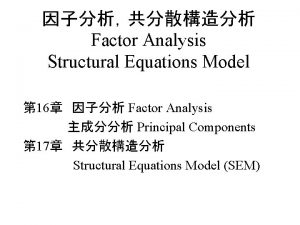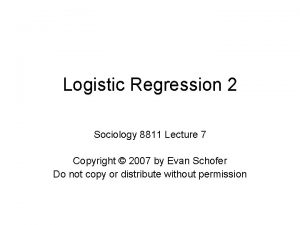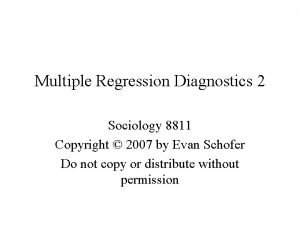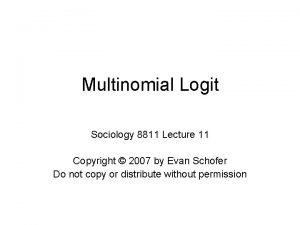Factor Analysis Structural Equation Models 2 Sociology 8811
































- Slides: 32

Factor Analysis & Structural Equation Models 2 Sociology 8811, Class 29 Copyright © 2007 by Evan Schofer Do not copy or distribute without permission

Announcements • Today’s Class: • Course Evals • Continue with factor analysis / SEM • Upcoming schedule: • Thursday: Guest lecture • Then we’re done!

Factor Analysis • Factor analysis is an exploratory tool • Helps identify simple patterns that underlie complex multivariate data – Not about hypothesis testing – Rather, it is more like data mining • And also helps us understand some principles of SEM

Factor Analysis • Things you can do with factor analysis: • 1. Examine factor loadings – Use them to interpret factors that are identified in the data • 2. Plot factor loadings – Vividly describe which variables “go together” (people score high on one tend to score high on another or vice versa) • 3. Compute factor scores – Estimate how individual cases score on underlying factors – How depressed is each case? • 4. Determine variation explained by factors – See which factors account for the major patterns in your data • 5. “Rotate” the factors – Modify them to enhance interpretability… Will discuss later.

EFA: Civic Participation • Factor loadings describe patterns in data • A powerful exploratory tool Rotated factor loadings (pattern matrix) and unique variances -----------------------------Variable | Factor 1 Factor 2 Factor 3 | Uniqueness -------+---------------+-------member | 0. 8061 0. 0974 0. 0139 | 0. 3405 volunteer | 0. 8055 0. 0377 -0. 0087 | 0. 3497 petition | 0. 0615 0. 3130 -0. 1456 | 0. 8771 boycott | 0. 1504 0. 5724 0. 0165 | 0. 6494 demonstrate | 0. 1358 0. 5614 0. 0671 | 0. 6619 strike | 0. 0371 0. 3536 0. 2421 | 0. 8150 occupybldg | -0. 0030 0. 2439 0. 2501 | 0. 8780 ------------------------------ Here, we see a clearer pattern… Factors 1 & 2 are more distinct. Factor 1 = civic membership; factor 2 = protest/social mvmts, etc…

Confirmatory Factor Analysis • Factor analysis is purely exploratory • It is data mining, not a model • However, it is based on the idea that factors – which are unobserved – give rise to (i. e. , cause) variation on observed variables Depression Happy WGood Hopeless Sad Tired

Confirmatory Factor Analysis • Idea: Let’s imagine that depression is a latent variable • i. e. , a variable we can’t directly measure… but gives rise to observed patterns in things we can observe • Note: No observed variable perfectly measures the latent variable – Each observable variable is a measure… but there is error – Observed variables aren’t perfectly correlated with latent variable (even though they are “caused” by it)…

Confirmatory Factor Analysis • This forms the basis for a kind of model: Depression B 1 B 2 B 3 Happy WGood Hopeless e e e B 4 Sad e B 5 Tired e

Confirmatory Factor Analysis • This model can be expressed as a set of equations: Depression B 1 B 2 B 3 Happy WGood Hopeless e e e B 4 Sad • Hopeless = B 3 Depression + e e B 5 Tired e

Confirmatory Factor Analysis • Full set of Equations: • • • Happy = B 1 Depression + e World. Good = B 2 Depression + e Hopeless = B 3 Depression + e Sad = B 4 Depression + e Tired = B 5 Depression + e

Confirmatory Factor Analysis • Idea: We can model real data based on those presumed relationships… • Estimate slope coefficients for each arrow – How do latent variables affect observed variables? • Examine overall model fit – How much does our theoretically-informed view of the world map onto observed data? – If model fits well, our concept of “depression” (and measurement strategy) are likely to be good • “Confirmatory” implies that we aren’t just “exploring” – Different from “exploratory factor analysis”… – Rather than data mining, we’re testing a theoretically-informed model.

CFA: Civic Engagement Models can be estimated with AMOS or GLLAMM

CFA: Civic Engagement Note: To solve models, 1 parameter for each latent variable must be set to 1. This defines units for latent variable

CFA: Civic Engagment Same model: Standardized coefficients… Note that the latent variable better predicts some vars…

CFA: Text Output Slopes Estimate S. E. C. R. P Volunteer <--- Civic Membership 1. 000 Member <--- Civic Membership 1. 588. 211 7. 517 *** Strike <--- Social Movement Participation 1. 000 Boycott <--- Social Movement Participation 3. 270. 386 8. 473 *** Demonstrate <--- Social Movement Participation 3. 165. 376 8. 406 *** Occupy. Bldg Intercepts <--- Social Movement Participation . 596. 105 5. 694 *** Estimate S. E. C. R. P Volunteer 1. 333 . 052 25. 639 *** Member 2. 328 . 060 38. 506 *** Strike . 058 . 007 8. 517 *** Boycott . 248 . 013 19. 691 *** Demonstrate . 207 . 012 17. 552 *** Occupy. Bldg . 041 . 006 7. 031 ***

CFA: Model Fit • So, did the model fit? • Many strategies to assess fit: Chi-square; “fit indices” – Ex: Chi-square test • Large Chi-square indicates that data deviate from model expectations – e. g. , when used to test independence in a crosstab table… • If model “fits” well, chi-square will be NON-significant – However, this is a sensitive test… if N is large, the model almost always yields a significant Chi-square… Result (Default model): Civic Participation N = 1, 200 Chi-square = 28. 379 Low p-value indicates significant difference Degrees of freedom = 8 between model and observed data Probability level =. 000 (not uncommon for large N model)

Model Fit: NFI • Another way to assess fit: NFI • Also called the Bentler-Bonett index • Where X 2 null is chi-square of null model (independence) • X 2 full is chi-square of model of interest • NFI ranges from 0 to 1 • NFI >. 9 = OK, NFI >. 95 is good.

Model Fit: CFI • Comparative Fit Index: CFI • CFI ranges from 0 to 1 • CFI >. 9 = OK, CFI >. 95 is good.

Model Fit: RMSEA • Root Mean Square Error of Approximation • RMSEA of 0 = perfect fit • RMSEA <. 05 = good fit • RMSEA >. 1 = poor fit.

CFA: Civic Engagement • Model Fit Summary: – Results greatly edited… many fit indices reported… Model Default model RMSEA NFI CFI . 046 . 979 . 985 1. 000 Saturated model Independence model . 231 Fit indices look pretty good. Not perfect, but OK.

Why Use CFA • 1. If CFA model fits well, it strongly supports theory underlying the model • Poor fitting CFA implies that the latent variables are not empirically present – Or don’t relate to observed variables in the way we specified • 2. CFA can be used to compare models • Are “petitions” part of “civic membership” or “social movements”? Or both? • We can use CFA to assess fit of various models – And settle debates about how measures relate to latent variables.

Why Use CFA • 3. CFA can be used to test applicability of models to different groups • Does model for US apply to other countries? Or just to those similar to US (e. g. , canada)? • Men vs. women… Are patterns of civic life the same?

SEM • Next step: Structural Equation Models (SEM) with Latent Variables • Once we’ve identified latent variables, it makes sense to analyze them! • We can develop models in which we estimate slopes relating latent variables… • This is particularly useful when we are interested in latent concepts that are difficult to measure with any single variable.

SEM: Civic Engagement Note that both latent and observed variables can be used to predict outcomes Also, under some conditions you can estimate non-recursive models (paths in both directions)

SEM: Divorce & Well-being • Example 2: Amato, Paul R and Julia M. Sobelowski. 2001. The Effects of Divorce and Marital Discord on Adult Children’s Psychological Wellbeing. American Sociological Review, 66, 6: 900 -921. • What is effect of divorce on (adult) children’s well-being • Answer: Divorce mainly has effects by harming parent/child relationship.

SEM: Divorce & Well-being Effect of divorce operates mainly via parent-child relations

Why Use SEM? • 1. Very useful when you are concerned about measurement error • Use of multiple measures for each latent variable can yield robust analyses, despite weakness of each measure • 2. Similar to path models (discussed in lab), but allows latent variables • You can model the relationship between many latent & observed variables at the same time

Why Use SEM? • 3. Additional information afforded by multiple measures can permit solution of “nonrecursive” models • i. e. , models where two variables have a reciprocal relationship • Ex: Self-Esteem School Achievement • If models are well specified, SEM may help tease out complex issues of causality.

Why Use SEM? • 3. (cont’d) Non-recursive models… – Issue: Identification • A big topic – can’t be covered sufficiently today • Obviously, we can’t estimate every causal path between vars… – Even if we imagine theoretical possibility of a relationship • “Identification” refers to a model that is solveable • Models with too many paths = not identified – You must simplify the model to allow a solution.

Why Use SEM? • 4. A powerful tool formalizing complex theoretical relationships • And testing those theories • Indeed, many refer to SEM as “causal modeling” – The theorist specifies causal paths based on theory, tests those paths…

Problems with SEM • 1. Model specification issues are even more complex than regression models • You are often dealing with MANY paths • If any part of the model is mis-specified, it will affect other parts of the model – Results are often unstable… • Adding a path between two variables can change results a LOT • It is easy to produce any desired result by tweaking paths… • Perhaps not a panacea for determining causality after all…

Problems with SEM • 2. SEM hasn’t been adapted to address many limitations of linear models • Generally can’t do non-linear models (ex: Poisson) – Though software keeps improving. Newest version of AMOS can handle ordered categorical data • Not designed to easily handle grouped data – E. g. , Multi-level models • 3. Still requires specialized software • LISREL, AMOS, EQS • Cumbersome – not user friendly.
 What is functionalism in sociology
What is functionalism in sociology Structural strain theory sociology
Structural strain theory sociology Functional perspective
Functional perspective Structural theory sociology
Structural theory sociology Structural strain theory sociology
Structural strain theory sociology Betti theorem
Betti theorem What is domain model in software engineering
What is domain model in software engineering What is modals and semi modals
What is modals and semi modals Kmo test
Kmo test Nn multi factor
Nn multi factor How to understand scale drawings
How to understand scale drawings Understanding scale drawings
Understanding scale drawings Structural equation modeling for dummies
Structural equation modeling for dummies Structural equation modeling
Structural equation modeling Dynamic structural equation modeling
Dynamic structural equation modeling Factor by grouping examples
Factor by grouping examples Factor out the greatest common factor
Factor out the greatest common factor Form factor and crest factor
Form factor and crest factor Examples
Examples Factor by greatest common factor
Factor by greatest common factor Factors of 48 and 60
Factors of 48 and 60 Energy method
Energy method Functionalism in media
Functionalism in media Structural functional analysis is given by
Structural functional analysis is given by Momentum structural analysis
Momentum structural analysis Satk mark
Satk mark Static analysis in ansys
Static analysis in ansys Structural analysis chapter 8 solutions
Structural analysis chapter 8 solutions Arches structural analysis
Arches structural analysis The internal loading can be found by
The internal loading can be found by Structural functional analysis is given by
Structural functional analysis is given by Indeterminate structures
Indeterminate structures Statically indeterminate
Statically indeterminate
